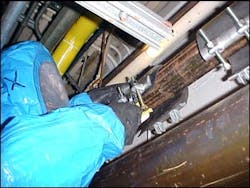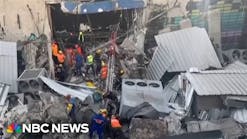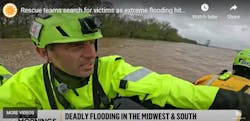"Oh-no! not another Level A suit up!" Those words were commonly heard when my team personnel found out about an imminent Level A drill. I would have to remind them that the public we serve expects us to be proficient when our services are required and that means drilling so we get it right but more so we don't get it wrong. Occasional reminders that our state regional contract also requires that we are competent, confident, and comfortable (the three C's) with our Level A skills were also worth the time. The challenge, then, was to devise and present training sessions that were worth their time. A way that I have found to do just that is to weave equal amounts of fun, challenge, and efficiency into Level A training sessions.
Level A Olympics
A real fun session that even the most grim team members enjoy is where Level A personnel compete in several sporting events. While in Level A suits, along with associated boots and gloves, personnel undergo a series of events whereby their scores are recorded by their dressing partner. While in Level A personnel will be scored in the number of passes of a football they can achieve in two minutes, the number of Frisbee tosses in two minutes, the number of golf putts in two minutes, the number of baseball hits in two minutes, and the number of laps while dribbling a basketball on a slalom course. Distances between the Level A person and the recording partner are determined in order to make it a level playing field and the individual events are weighted because some take more time than others to complete.
After each suited person completes each of the five events they doff their suits and the recorder adds up their scores. After all personnel suit-up and compete, the top scores are rewarded with prizes that can be either significant (tangible rewards) or insignificant (candy). What I have found is that personnel like the recognition of winning these events and take pride when they come out on top. Obviously, the parallel reward is that personnel enjoyed themselves while they simultaneously maintained their Level A skills. They are also challenged because it is not uncommon for personnel to become fogged up while in the suits and then they have to deal with the loss of vision during the competition.
We try to conduct the Level A Olympics once a year while changing some of the events to prevent boredom and even challenge personnel more. Events such as shots on a hockey goal or even constructing nut, washer, and bolt combinations can be substituted or added into the competition. We even use the Olympics in initial training sessions for new team members with great success. It seems to be a great way to introduce personnel to Level A and the perceived difficulties that have to be overcome in order to be proficient.
The bottom line with this training approach is the fun personnel have while maintaining their Level A skills. To extend the idea, future sessions will include forming teams to compete in volleyball games, all while in Level A. Since no two team members breathe their air at the same rate the teams will lose their members the longer the game goes on. Therefore, the winner needs to be carefully considered between the score and the longevity of team members. At any rate, a fun time will be in store!
Challenge and Efficiency through Hands-on Drills
Another drill we have been using to maintain skills is sealing leaking pipes at an old dairy building. Our training site is an abandoned dairy that still has intact pipes, pumps, and reservoirs from an ammonia cooling system. While the active dairy was a source of numerous hazmat emergencies for our team due to an antiquated ammonia system, the ammonia has all been evacuated and the system has been rendered safe.
The challenge with this drill is sending Level A personnel deep into the building that has no electricity. Teams have to negotiate their way in with artificial light and then apply pre-made leak sealing devices to pipes that have simulated leaks. Personnel have to climb ladders and negotiate numerous pipes in order to apply the device and complete the evolution.
Personnel have commented on the difficulty of the evolution but can see the skills that are needed and maintained as a result of the drill. In order to complete the evolution teams take air monitors in with them along with the leak sealing kit, hand tools, and a step ladder. Accompanied by a drill controller, teams may be directed toward insights of how to perform more efficiently as a team or how to operate equipment. The training-in-context method works well on this evolution and a short discussion after personnel exit the building summarizes all of the lessons that were learned during the evolution.
In conclusion, in concert with other training methods and specific drills personnel are challenged throughout the year through drills that are designed to maintain Level A skills. We have found that by adding drills that are fun and also challenging and efficient team personnel seem to enjoy their training sessions and do not look at them as sheer drudgery and a waste of their time.
By conducting the Level A Olympics and the leaking pipe drill at the Old Dairy we have found that we can avoid the "oh-no! not another Level A suit-up!" exclamation from team personnel and even have some fun at training sessions.
As usual, please contact the author at [email protected] or through the website www.hazmatpetie.com with comments or questions.
DAVID PETERSON, a Firehouse.com Contributing Editor, is a 28-year fire service veteran who serves as a lieutenant and training officer in Madison, WI, and as the training coordinator for the department's regional Level A HazMat team. David founded the Wisconsin Association of Hazardous Materials Responders, Inc. and teaches, presents, and authors articles on a wide variety of fire and hazmat topics. David is also a National Fire Academy instructor of chemistry and a Master Instructor for the International Association of Fire Fighters HazMat and Terrorism training programs. To read David's complete biography and view his archived articles, click here. You can reach David by e-mail at [email protected].






